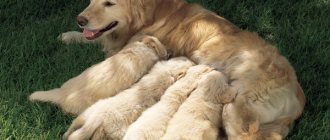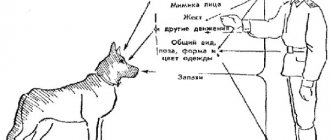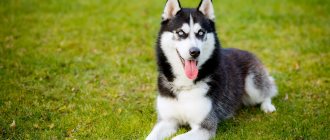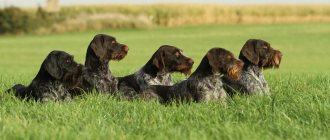At what age do you start training?
Puppy training must begin from the very first days
the presence of a dog in your home. Because already from infancy, the puppy must learn the rules of behavior in your house, what is allowed and what is forbidden, how to behave with all family members, even the smallest and oldest, what he can play with and what he can’t, where to go. toilet and much more.
And we are talking, first of all, about the proper upbringing of a Bernese Mountain Dog puppy, and you can start training and learning commands when the puppy is completely comfortable in your home. As a rule, one week is enough. By this time, the puppy is already filled with curiosity and is diligently exploring the world around him. If, after this time, the puppy remains fearful and does not make contact well, then it is better to seek help from a dog handler-animal psychologist, because This behavior is not typical for puppies of this breed.
When can you start training with a dog handler?
The beginning of the puppy's training coincides with the time of the first exit to the street. When the first two vaccinations have already been done, the quarantine (lasts 7-14 days, depending on the vaccination) after them is over. It is not at all necessary to train your puppy only outside; the first sessions are best done at home, where there are fewer distractions.
Often new puppy owners worry that training from the first days will be excessively stressful for the dog. This is only possible if outdated, rigid methods are used, and with the right approach, training from the first days will, on the contrary, be very useful, since it allows you to immediately establish contact
with the puppy and build a trusting relationship.
You can start raising a puppy from the first days of its appearance in your home, and training and classes with a dog handler can begin simultaneously with the start of walks, when quarantine ends after the second vaccination.
Why you don't need to wait up to 6 months
You often hear that Bernese Mountain Dogs, like other dogs, cannot be trained before 6 months of age because training is stressful. This opinion remains from the times of outdated methods based on cruel coercion and intimidation of the dog. Unfortunately, there are still plenty of dog handlers using similar techniques today. But fortunately, science does not stand still and modern techniques make it possible to train a puppy from the first days in a new home. Therefore, you should not wait until unwanted behavior is established in your Bernese Mountain Dog puppy; you can start training much earlier.
Education and training
The Bernese Sinnenhound was a dog with excellent working qualities in the past, but even in modern times, when they are companion dogs, they have retained their mental alertness, good memory and intelligence. To raise an obedient and adequate dog, regular training and training is necessary.
Experts advise that the initial stage of training should be carried out at approximately 5-6 months and these should be obedience exercises. At 9-12 months it is advisable to conduct a course of special training. Later, when the dog’s psyche is formed (this happens by 1.5 years), the Bernese Sinnenhund is ready for a general training course (GTC).
Hereditary traits make themselves felt: representatives of the breed are excellent at the basics of guard duty and protective training. The owner just needs a little persistence and exclusion from routine and monotonous repetitions. Dogs do not like boredom and are more accepting of training that is done in a playful way.
Training at 2 months. Upbringing
At 2 months old, your Bernese Mountain Dog puppy is still at home, in quarantine after the first vaccinations, and he is not yet allowed to go for walks. Therefore, it’s time to start raising a puppy in the home conditions that are already familiar to him.
Toilet training
The first step is teaching the puppy to go to the toilet in a diaper . You should not rush to teach going to the toilet directly outside, bypassing this stage, because puppies are not physiologically ready for walking twice a day. This ability is developed in Bernese Mountain Dog puppies no earlier than 6 months, and in some up to 1 year.
It should be remembered that any learning is a rather complex thing and, seeing the first positive results, you should not think that your puppy has already understood everything, but you should continue training according to the method, so that after a while you do not have to start all over again.
Collar and leash training
The second important point will be to accustom the puppy to a collar and leash . Yes, yes, this should be done at home, so that by the time the puppy goes outside for the first time, wearing a collar will not be additional stress for him, but is already a familiar thing, and he can start exploring the world around him, rather than trying to get rid of an unknown object.
What to allow a puppy and what not
The third point, which causes the greatest difficulty for new puppy owners, will be determining the puppy’s boundaries of what is permitted. Often, many novice dog owners think that the unwanted behavior of a Bernese Mountain Dog puppy will “go away on its own, outgrow it.” But, unfortunately, the behavior that is allowed for a puppy will be taken for granted later by an adult dog.
.
Any unwanted behavior in a puppy WILL NOT go away on its own, but will only become stronger over time.
Therefore, it is necessary to start defining the puppy’s boundaries of what is permitted now. You will need:
- Teach to play only with your toys, and not with your things;
- Explain that you cannot bite your hands even in a game;
- Establish the correct daily routine, establishing the rule that in the morning you need to sleep and not wake you up;
- Stop chewing furniture, clothes, walls and baseboards;
- Teach to stay home alone, knowing that your absence is not a reason to bark or howl.
IT IS EXTREMELY IMPORTANT TO KNOW: constant and excessive punishments that follow almost every action of the puppy have a detrimental effect on its fragile psyche and can lead to the fact that the Bernese Mountain Dog puppy grows up cowardly and embittered. For normal natural development, a puppy must have the opportunity to explore the world around him, which is currently limited to your apartment or house.
Introduction to Basic Commands
Already now you should begin to familiarize yourself with the initial obedience commands in a light playful form, while focusing on rewards for execution, because the puppy’s psyche is still quite plastic and excessive severity and exactingness can lead to the puppy being intimidated and cowardly. Therefore, it is necessary, first of all, to try to interest the puppy by offering him a toy or treat, and sometimes just praise.
Characteristics, description, character
Bernese Mountain Dogs grow up to 58-69 cm for females and 61-71 cm for males. Their weight can range from 36 to 48 kg (females) and from 38 to 50 kg (males).
The breed is characterized by a three-color color with a basic black color, red tan markings on the cheekbones, on four legs, and on the chest with transition to white markings.
Dogs have long, straight or slightly wavy hair and a bushy tail. She is distinguished by excellent instincts, mobility, strength and fearlessness. It was these qualities that were developed in the representatives of the breed, as they were necessary for the successful fulfillment of their tasks - herding the herd, finding lost cattle and bringing them to the farm (sometimes the dogs urged cows and bulls, pushing them by their hind legs, but without biting), transport goods, guard the house.
The Bernese Mountain Dog's character, or rather its most striking character trait, would be defined by: loyalty. A hundred years ago and now, the meaning of a dog’s existence was devotion to its owner, the desire to be useful to him. The Mountain Hound awkwardly shows sympathy and love for all family members. They get along with everyone, including pets and children.
Like all herding dogs, Bernese Mountain Hounds are not dominant dogs, so in the company of other pets in the family they will be lower in the hierarchy.
Dogs are very demanding when it comes to the love and attention of their owner. Their absence will make the pet unhappy.
Sennenhounds are active, but their mobility is a temporary phenomenon, since most of her time she likes to lie down, and if she participates in work with the owner, then with obligatory rest breaks. If you need a dog to accompany you on long walks or bike rides, then this is definitely not the Bernese Mountain Dog.
Hereditary traits make themselves felt: dogs are always attentive to what is happening around them. They know the daily routine of each family member and immediately notice any deviations without making a fuss. They defend their territory from outsiders.
Thanks to their beauty, measured activity and boundless devotion, Mountain Hounds are companion dogs that a large number of people want to have.
Training at 3 months. Socialization
Three months is an important stage in a Bernese Mountain Dog puppy's introduction to the outside world. Your first walks should be short and not too tiring for the puppy. You should start with 15 minutes, gradually increasing the walking time to 1 hour.
Correct formation of the nervous system
At this age, the puppy’s nervous system is forming.
. It has been proven that raising puppies in isolation during this important period contributed to the development of pronounced cowardice in them later. It is necessary to show the puppy as much as possible: noisy streets, large crowds of people, etc. Everything that he will have to face in later life.
This must be done very carefully, gradually, over and over again increasing the time spent in noisy places, so as not to overload the puppy or frighten him.
The territory of a country house, cottage or village are places with a minimum amount of external stimuli for a city dog. Therefore, if you plan to keep a dog in an urban environment, “growing up” a Bernese Mountain Dog puppy in such conditions depleted of irritants is unacceptable.
A city puppy must grow up in the city, in conditions that are saturated with external stimuli, such as: noisy streets, large crowds of people, other animals, birds, cyclists, cars, etc.
Meeting people and dogs
It is necessary to introduce the puppy to friendly dogs and people
so that later the puppy does not develop aggression or cowardice caused by the fear of new things and the inability to communicate and make new acquaintances. Currently, unfortunately, this is not uncommon in the behavior of adult dogs, but a fairly common problem with which people turn to our specialists for help.
Puppy behavior on the street
The emergence of new places leads to new rules that need to be consolidated:
- Now you can and should go to the toilet on the street, and not stoically endure it, carrying everything home;
- Not every new person or dog wants to communicate, so you don’t need to run headlong to meet everyone;
- Not all food is healthy, so it should only be taken from the owner’s hands.
Training and practicing commands
Training a puppy follows the same principles as at 2 months. It should be remembered that at this age puppies develop conditioned reflexes quite easily, but they are forgotten just as quickly, so you should not scold the puppy for not following commands, especially if they have not been repeated for a long time, but you should pay more attention to learning new things and repeating already covered material .
Care and maintenance
The breed sheds all year round, so the Bernese Mountain Dog requires careful grooming. Owners can have some control over the molting process. By brushing your pet daily, you can significantly reduce the amount of hair on furniture and floors. When shedding begins to subside, it is enough to brush your dog once a week.
If tangled areas have formed on the fur, you can cut them off or gently comb them. You need to bathe your dog once every 4 months or if it is very dirty. It is better to use special shampoos for long-haired dogs. White marks should be given more attention to remove any dirt.
Caring for teeth, ears and eyes includes procedures typical for all dogs. If there are any deviations in the condition of these parts of the body, then you need to contact a veterinarian to rule out infections.
The breed is very susceptible to hot climates, so it is necessary to create a cool place in the room where the pet spends the most time. Excessive heat, such as while walking, can lead to heatstroke, and prolonged exposure to a heat source can lead to skin problems.
Training at 4 - 5 months
By this time, the Bernese Mountain Dog puppy has already become accustomed to your home and usual walking areas, and no longer needs your support and care so much. He begins to flirt with other dogs, pretend that he does not hear you when you call him, and show a certain persistence and disobedience when performing various commands.
This means it's time to move on to full training . In classes at this age you can already be persistent and demanding. At the same time, the most important thing is not to overdo it, remember that classes should bring joy to both you and your dog, and only then you can achieve the desired result.
Required commands in 4 months
What commands are practiced by a Bernese Mountain Dog puppy at 4 months:
- Calm movement next
to the owner with and without a leash, with landing when stopping, with a change in pace and direction of movement - Return to you
upon request - Staying
in a free or certain position (sitting, lying, standing) for a long time: if necessary, wait for the owner on the street, when visiting a store or other establishment - Indifferent attitude towards treats scattered on the ground
- Inhibitory command
to stop unwanted actions - Execution of a set of commands “sit”, “lie down”, “stand”
at a distance and near the leg, when giving commands by voice and gestures - Stop barking
on demand.
Kennel of Bernese Mountain Dogs and Papillons. Professional approach.
Having bought a dog, we should immediately think about what we want to get from it: a pleasant, obedient friend or a creepy monster? After all, even the smallest dog, which is not taught the rules of behavior, can make your life terrible. And in the end, you will increasingly think about where to place it.
I won’t read morality for a long time, I’ll just tell two stories...
We bought our first mountain dog, a female, to make it easier to keep in the apartment (we initially decided so). We brought this miracle home, and it turned out that our dog was terribly clean. From the very first time she began to pee on her diaper, no one taught her this, although we took her from the nursery and she began her life on the street.
There are not many problems when walking with a small (young) dog. If anything happened, I pulled her up with a leash and that was fine. And our Merka began to grow quickly, gain weight, tried to rush to all the dogs, strangers, especially children... I wonder who these little people are? It looks unpleasant, and you feel like... it’s unclear who is walking with whom! Are you with the dog or is it with you? But what can I tell you here? You yourself have probably observed such situations more than once.
And we began to practice obedience. All basic commands: next to you, sit, lie down, place, etc. according to the OKD program. It turns out that different dogs have different approaches to training. Some, the so-called “food workers” work only for food, this was our option.
Other, “playing” dogs work for their favorite toy.
You will have to spend about 1 year on training, but you will have much longer to live with this dog...
A year later, we passed the OKD to 1st degree. We can say for sure that our Mary is a well-mannered, intelligent dog. I can go to the veterinary clinic with her alone, sit in line with other dogs (and for many this is a real problem). And if we are going somewhere, we never question whether to take the dog with us. She is truly a true friend and a pleasure to be with all the time.
Two weeks after us, my friend bought a small dog (miniature pinscher), also a male. And I decided that it was a toy. Why raise him, she told me? If anything happens, I’ll take him in my arms for a walk. And if it’s dirty, then also on your hands? He barks at dogs all the time, big ones at that, but what if someone bites him?
At home he pees wherever he wants, marks his territory, especially when he grew up and began to raise his leg, all the white leather chairs were ruined. But how can you punish him? He is so small and also very fast (we don’t have time to catch up with him). He found himself a place where no one would get him and, having mischievously, immediately rushes there to hide.
He jumps great, well done. He jumps onto chairs in the kitchen and any dishes disappear from the table from the plate in a split second. But why educate him, because he’s small... we’ll also laugh a couple of times after, oh, what a mischief, touchingly! But when this happens every day, day after day. Tired of washing sofas, cleaning the luxurious carpet, pushing chairs under the table. The smell in the apartment intensifies, you begin to wonder where to put it, your precious, beloved dog. After all, not all people are patient and ready to bear “this cross.”
Retraining a dog is much more difficult than immediately explaining the rules to it. She doesn’t understand why it was possible yesterday, but today it’s no longer possible. And she will try to push you for a long time. And, if it was never possible, then it’s definitely impossible! And in this case, you will no longer encounter SUCH perseverance.
So why bring the situation to the point of absurdity? A dog is our choice, we are responsible for the one we take. It doesn't matter whether the dog is small or big, they can turn our lives into a nightmare. When they tell me, equip a balcony for the dog and let him live there, I’m shocked, how can I not constantly see her, be with her, have contact?! She doesn’t bother me, the only thing is that I have to step over her while she’s resting on the floor. This is truly a family member that we want to be with all the time.
Of course, during the training process you need to be consistent, patient and very observant. Your efforts will not be in vain and after some time, you will be rewarded with a smart, obedient and attentive dog.
But that's another story...
Training from 6 months
At this age, the puppy begins puberty and the real rebel awakens in him. He begins to re-test the boundaries of what is permitted and, sometimes, deliberately does not respond to your commands, only in order to look at your reaction. If she is not what the puppy expects to see, then he may decide that now he can no longer carry out your commands.
Remember that a puppy is still a child.
, and excessive harshness can forever undermine his trust in you.
At this stage of the Bernese Mountain Dog puppy's growing up in training, all the shortcomings made at the previous stages, which were smoothed out by his young age, become clearly visible. And if they appear, it’s time to correct them.
In many training schools, there is an opinion that a puppy needs to be trained in two stages, the first at an early age, and the second at 8 - 10 months, in order to “consolidate” what has been learned. This is not an entirely correct position; this opinion appeared when newer operant training methods began to be added to the old “DOSAAF” rigid training methods, where they began to work with the puppy strictly after 6-7 months, including working with the method of pointing and following the “target”.
Their weakness was that they were two different techniques.
, which began to be used without adapting to each other, having a huge gap between their tools for developing training skills. The difference between them is like between choreography lessons in kindergarten and army drill training. Therefore, they required training in two stages, which were in no way connected with each other.
Modern methods based on zoopsychology make it possible to train a puppy in a single system , when no additional stages of training are required.
Training
- Dogs are smart and easy to train. You need to find a common language with the puppy.
- The time for constant training, physical activity, and mental exercises must be unlimited, otherwise there will be a decrease in the intellectual abilities of the Swiss.
- It is better to train your dog in the fresh air. Go for runs, play actively, but remember that you cannot overload your dog during the period of growth and development. The owner must have a strong character and not allow the dog to dominate.
- During training, you cannot shout or physically influence the dog; the trainer must be collected, focused, attentive, and the commands must be clear.
- Encourage your pet with praise if he deserves it.
You cannot miss moments of education; if you have difficulties, contact a professional.
Our dog handlers
Bernese Mountain Dog training specialists
Alexander Chaplygin Dog psychologist-zoopsychologist
Experience: 37 years Read more..
Ekaterina Panova Dog psychologist-zoopsychologist
Experience: 34 years Read more..
Yaroslav Morozov Dog psychologist-zoopsychologist
Experience: 25 years Read more..
Lada Yurtseva Dog psychologist-zoopsychologist
Experience: 21 years Read more..
Victoria Fox Dog psychologist-animal psychologist
Experience: 14 years Read more..
Ekaterina Budkina Dog psychologist-zoopsychologist
Experience: 13 years Read more..
Evgeniy Bravinsky Dog psychologist-zoopsychologist
Experience: 17 years Read more..
Vitalia Bravinskaya Dog psychologist-zoopsychologist
Experience: 10 years Read more..
Kira Ageeva Dog psychologist-zoopsychologist
Experience: 19 years Read more..
Evgenia Zuber Dog psychologist-zoopsychologist
Experience: 12 years Read more..
Tatyana Melnikova Dog psychologist-zoopsychologist
Experience: 10 years Read more..
Alexey Melikhov Dog psychologist-zoopsychologist
Experience: 22 years Read more..
* Check with the managers for the possibility of a specific specialist visiting the area you specified. If the desired dog handler does not work in your area, then we can offer you another specialist from the above.
Training a Bernese Mountain Dog puppy in
When you turn to our canine center for help in training a Bernese Mountain Dog puppy, you can be sure that a real specialist in his field
and will provide training at the proper, highest level.
- A dog trainer will come to your
home at a time convenient for you. - Classes are held 1-2 times a week
, depending on the program. - Instructors work from 9:00 to 21:00
, on weekends inclusive - The training program is drawn up at the first lesson,
taking into account the breed, age, personal characteristics of the dog and your wishes for training - Some classes take place at home
, some
outside
, depending on the topic of the lesson. - Puppy age
from 2 months
Our Center employs dog handlers - animal psychologists who have experience in working with Bernese Mountain Dog puppies and training adult dogs from 10 to 35 years old, who know all the nuances of their behavior
and features of training at each stage of a dog’s growth. Therefore, your pet is guaranteed to learn to carry out your commands the first time in any conditions, and will become your faithful and reliable companion.
Description and appearance of the Bernese Mountain Dog
The Bernese Mountain Dog is a large dog with a harmonious build.
A male reaches a height at the withers of 64-70 cm, a weight of 35-55 kg, a female reaches a height of 58-66 cm, her weight is 35-45 kg. The head is proportional to the body, the neck is thick and powerful, the muzzle without a sharp frontal transition. The eyes are almond-shaped, the iris is brown. The ears are triangular, medium in size, drooping, raised when alert. The nose is black, with large nostrils. The teeth are strong, even, scissor bite, pincer bite is also allowed. The back is wide, with a short loin, the chest is deep, the ribs are convex. The limbs are straight, widely set, paws are rounded. The tail is saber-shaped, tapering towards the end. The coat is elongated, straight or slightly wavy. The color is tricolor - black combined with white and red spots.
Deviations from the standard are considered:
Take the Attention Test! Find 10 differences! (click right here!)
Find the answer Are you bothered by some problem or question? Enter “Breed” or “Name of the problem” into the form, press Enter and you will find out everything about the issue that interests you.
- lightweight frame;
- incorrect placement of incisors;
- curly coat;
- absence or predominance of white areas on the head;
- black fur on the body with a brown or red tint;
- asymmetrical color;
- the presence of white spots with a grayish tint;
- snack or undershot;
- entropion of the eyelid;
- tail with creases;
- bifurcated nose;
- “peeping” undercoat;
- aggression or timidity;
- cryptorchidism in males;
- low growth.
The best purebred representatives can be seen at exhibitions organized by breeders.










